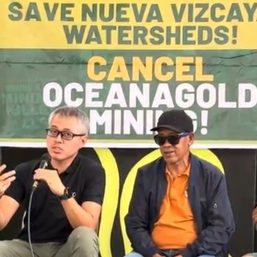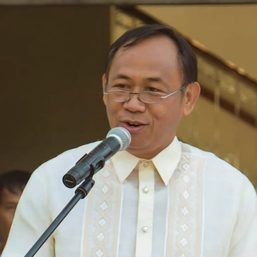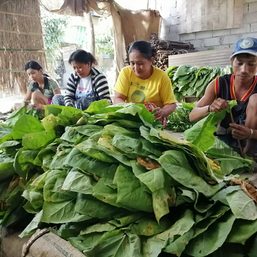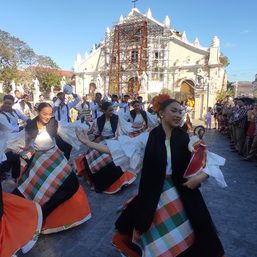SUMMARY
This is AI generated summarization, which may have errors. For context, always refer to the full article.

Second of 5 parts
BAGUIO CITY, Philippines – There is a misconception that the late president Ferdinand E. Marcos reinforced the Solid North by providing aid and support to the Ilocano people.
The common perception was, “that Ilocanos were voting solidly for the Marcoses not just because of the ethnic ties to the north, but also because the Ilocanos had a relatively better experience as compared to the other parts of the Philippines during the Martial Law period, with Marcos pouring over billions of funds, especially in his home province of Ilocos Norte,” UP sociology professor Reidan Pawilen wrote in “The Solid North Myth: An investigation on the status of dissent and human rights during the Marcos Regime in Regions 1 and 2, 1969-1986.”
Jessie Vizcarra, a human rights lawyer from Vigan City, Ilocos Sur, said this popular view – still common today – glosses over the history of Ilocano activism at that time and the repression suffered by Ilocanos during the Martial Law period.
Vizcarra agreed with Pawilen’s view that for the North to be solid, Ilocos had to be broken down.
He said that in forming the Solid North in 1965, Marcos had to build alliances with known political warlords at that time. These were congressmen Floro Singson Crisologo of Ilocos Sur, Miguel T. Cases of La Union, and Antonio Raquiza of Ilocos Norte.
Raquiza had been a congressman of Ilocos Norte from 1949 until 1966, and then again from 1978 to 1986. He also served briefly as governor from 1955 to 1957.
After forging an alliance with Marcos, Raquiza became secretary of public works, transportation, and communications.
Cases was a five-term congressman of the 2nd District of La Union from 1946 to 1965.

The most notorious of Marcos’ allies was Crisologo. He and his wife Carmeling Pichay Crisologo, who served as governor from 1964 to 1961, were the conjugal political kingpins of Ilocos Sur.
Floro was part of the Marcos Cabinet in 1965, when the former Senate president crushed president Diosdado Macapagal’s re-election bid.
He and Raquiza were the only politicians in the early Cabinet filled with technocrats and political administrators.
“While President Marcos relied on political administrators like Salas and Syquio for administrative and program results, he maintained his contacts with old political friends. To some extent, this was forced on him by the Nacionalista Party elite who did not particularly like the way the president was running the country and the party,” wrote Aprodicio Laquian of the International Development Research Centre in 1970.
Floro Crisologo was widely touted to have authored the bills creating the Social Security System and the Tobacco Law.
Virginia tobacco was then a burgeoning cash crop in the country. The Crisologos tried to monopolize it in Ilocos Sur by establishing the Farmer’s Cooperative Marketing Association (Facoma), which bought the tobacco harvest of the farmers. They also built a tobacco leaf drying plant in the province.
The Crisologos also organized a 300-member private army, which the residents nicknamed the “saka-saka” or the “barefooted.”
The saka-saka was used for the tobacco blockade to ensure that the Manila-bound trucks filled with tobacco would pay their “tax,” sometimes amounting to $100 for each truck. In 1965, the Philippine currency’s value was around P3.90 to one dollar.
Also, the saka-saka would ensure another Marcos victory in the November 1969 presidential elections.
Pyrrhic victory
In 1969, President Marcos geared for his second – and supposedly final – term against then-Cebu senator Sergio Osmeña.
And, again, the Solid North delivered the votes for its native son.

If the 1965 elections were a Hollywood battle, the 1969 elections seemed like a typical Pinoy gangster movie.
It marked the first time that “Three Gs” – or guns, goons, and gold – entered the lexicon of Philippine political terms.
“During his 1969 reelection effort, President Marcos stumped vigorously, reaching even remote villages to personally place a check for two thousand pesos in the hands of each barrio captain, obligating them, in the country’s political culture, to use every possible means to deliver a winning margin,” wrote Alfred W. McCoy in his 2009 book, Policing America’s Empire.
Marcos became the first t Philippine president to win a second term.
He garnered 5,017,343 votes against Osmeña’s 3,043,122 – winning in all provinces, except Pampanga and Antique.
The grip of Marcos on his Solid North was almost the same as in 1965.
He got 777,514 votes, or 80%, from the Solid North provinces of Abra, Batanes, Benguet, Cagayan, Ifugao, Ilocos Norte, Ilocos Sur, Isabela, Kalinga-Apayao, La Union, Mountain Province, and Pangasinan. Osmeña only got 197,462 votes. Eerily enough, that was the same winning percentage he got in the Solid North in 1965.
Ilocos Norte gave their hometown boy 80,631 votes or a whopping 98.5%. Osmeña got only 1,215.
Ilocos Sur and La Union gave similar winning percentages of 91%.
But it was a pyrrhic victory for Marcos.
“This strategy cost Marcos a hefty $50 million, far more than the $34 million Richard Nixon had spent to win the U.S. presidency in 1968,” McCoy pointed out in his book.
“Overspending by the government occasioned by the 1969 re-election campaign of Mr. Marcos precipitated the third balance-of-payments crisis in 1970,” former UP professor Manuel F. Montes, now a senior advisor on finance and development at the South Centre in Geneva, wrote in a 1987 paper, “Stabilization and Adjustment Policies and Programmes,” for the United Nations University World Institute for Development Economics Research.
What followed, he added, was the 1970 International Monetary Fund-sponsored adjustment program. This required a 43% devaluation and the reduction in selected tariff rates.
“The reforms effectively brought to an end a brief and half-hearted flirtation with export-led growth,” Montes pointed out.
The 2 Gs
Despite the Philippines losing almost half its currency value in the process of securing Marcos’ re-election, “gold” was only one-third of the Marcos strategy.
“The 1969 campaign also produced incidents of political terror of the sort not seen since the 1951 elections. With the [Philippine] Constabulary now under the command of Marcos loyalist Vicente Raval, the PC’s Special Forces orchestrated violence in four swing provinces that left forty-six dead,” wrote McCoy.
One of these swing provinces was Batanes.
“In its ruling on these violations, the Supreme Court was particularly critical of what it called the ‘rape of democracy in Batanes,’ a remote island where the Special Forces allowed motorcycle-riding goons dubbed the ‘Suzuki boys’ to coerce a winning margin in the congressional race for a close Marcos ally,” McCoy said.
The Supreme Court in April 1970 issued an en banc decision affirming the Commission on Elections (Comelec) resolution to annul the proclamation of Marcos ally, Rufino Antonio Jr., as congressman of Batanes. Rejecting the election returns from 21 precincts in the island province, the High Court proclaimed Jorge Abad as the winner.
Abad is the father of Florencio “Butch” Abad, who became the representative of Batanes in 1987 before briefly serving as secretary of agrarian reform, and again from 1995 to 2004.
During the 1969 elections campaign, another Marcos alliance would fall.
“The height of the Solid North was also the peak of the 3Gs of the Constabulary and the private armies,” said Arnold Molina Azurin.
“The investigative reports on poll-related incidents in Ilocos Sur by Jose Burgos for the Manila Times include ambuscades and arson,” he added.
“Solid North thus became as peaceful as a graveyard and solid as a bullet,” he said.
In September 1969, Crisologo’s saka-saka killed the former mayor of Bantay town, just a stone’s throw away from Vigan.
A month later, the prosecutors indicted Crisologo’s son, Vicente, for being the mastermind.
“During the elections, the presence of ROTC cadets and hundreds of seminarians guarded the ballots while some held processions with lit candles to accompany the ballots to local Comelec precincts,” Azurin said.
After the elections in May 1970, Vicente again led the saka-saka in burning Bantay’s Ora Este and Ora Centro for supporting the opposition in the province.
Azurin said the stories of Burgos brought the Bantay inferno to Manila.
“Operation Bantay” was formed by 42 civil society and religious groups in Ilocos Sur to demand justice for the burning of the two villages.
Marcos ordered arson charges filed against Vicente Crisologo.
But the Crisologos were not yet finished.
Floro Crisologo reportedly went to Malacanang to demand that Marcos give him his share of victory spoils from the Solid North.
He reportedly threatened to expose the role of Marcos and his cousin Fabian Ver in cornering the tobacco monopoly in the Ilocos Region.
In October 1970, Floro Crisologo was shot dead in the head while kneeling inside the St. Paul Metropolitan Cathedral in Vigan.
Fifty years later, his attackers could come out and still be immune from prosecution, but the crime remains unresolved.
Carmeling Crisologo said that she was not interested in pursuing the case.
Son Vicente was convicted of arson in 1970 and sentenced to double life imprisonment. Before his actual imprisonment in June 1972, he still managed to run as mayor of Vigan in 1971.
He lost to Evaristo “Titong” Singson, while Carmelita lost to Luis “Chavit” Singson, Vicente’s cousin and Titong’s brother.
Thus was born the reign of Chavit Singson, who remains Ilocos Sur’s political kingpin.
President Marcos in 1980 pardoned Vincent, who was released from prison seconds before the New Year on December 31, 1980.
He would later serve as Quezon City 1st District councilor from 1998 to 2004, then successfully campaigned for the district’s congressional seat. He served three terms until 2013 and returned after a one-term break in 2016, becoming the Deputy Majority Leader in the House of Representatives.
Chavit is one of Ferdinand Marcos Jr.’s main campaigners and financiers in 2022. Though he claims to be retired from politics, his shadow will be as formidable as that of Floro Crisologo in the Cabinet of Marcos the father. – Rappler.com
(To be continued)
Read the series here:
- Solid North ‘bus’ zooms on as political juggernaut
- Ilocano diaspora created Solid North, Fluid North
- Solid North rebounds years after Marcos’ exile, death
This series has been made possible by Internews.
Add a comment
How does this make you feel?


![[Newspoint] Willful indifference](https://www.rappler.com/tachyon/2024/05/np-willful-indifference-05032024.jpg?resize=257%2C257&crop=270px%2C0px%2C720px%2C720px)







![[In This Economy] Marcos’ POGO ban is popular, but will it work?](https://www.rappler.com/tachyon/2024/07/thought-leaders-marcos-pogo-ban.jpg?resize=257%2C257&crop=255px%2C0px%2C720px%2C720px)
![[Rappler Investigates] POGOs no-go as Typhoon Carina exits](https://www.rappler.com/tachyon/2024/07/newsletter-graphics-carina-pogo.jpg?resize=257%2C257&crop=424px%2C0px%2C1080px%2C1080px)















![[OPINION] From ‘Puyat’ to ‘Tulog’: Clout-chasing street signs disrespected history](https://www.rappler.com/tachyon/2024/07/gil-puyat-july-26-2024.jpg?resize=257%2C257&crop=389px%2C0px%2C1080px%2C1080px)


![[Time Trowel] Yamashita gold is a myth, and treasure hunting is not archeology](https://www.rappler.com/tachyon/2024/06/myth-yamashita-treasure-june-14-2024.jpg?resize=257%2C257&crop=435px%2C0px%2C1080px%2C1080px)
There are no comments yet. Add your comment to start the conversation.